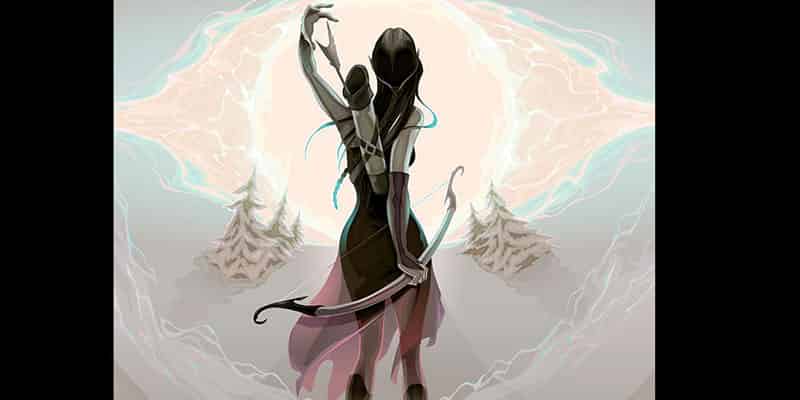The wood elf ranger is as classic as Dungeons and Dragons itself. With heightened senses, tactical prowess and a supernatural connection to the wild, rangers fill an important role in a party. They’re the professional adventurers of the group—the guides, scouts, trackers and hunters.
Inspired by the purest form of this old D&D trope, I wanted to build the ultimate version of the wood elf ranger in 5e. I decided the character would be the apex hunter of hunters, the big game hunter of DnD 5e monsters. Build like so.
- Dexterity and Wisdom top scores, in that order
- Choose archery fighting style at 2nd
- Mix a few animal spells with damage spells
- Take Hunter archetype at 3rd level
- Max out Dex/or Choose Sharpshooter feat at 4th level
- Lean into the class abilities for role
Before we jump in, check out my original pirate adventure to give your new ranger a tropical island to explore. Click here or below for more info.
Dexterity and Wisdom
Building this character to its optimum damage output means focusing on the most important ability scores. For this hunter, Dexterity is by far the most important score. In 5e, Dexterity scores affect accuracy, damage output, initiative and armor class. This completely covers how my ranger moves in battle.
The fact that wood elves receive a +2 bonus to Dexterity only cranks that top number up another notch. I’m convinced that this character build-out can mostly run on Dexterity alone, but Wisdom scores are helpful in other ways.
Wisdom will affect my ranger spells and soft abilities. So, this score covers a wide range of abilities I’ll want outside of battle. Everything from talking to animals to Survival skill checks will need a boost from my Wisdom score. Good thing wood elves also receive a +1 bonus to Wisdom, because ranger-ing is what they do.
Choose archery fighting style at 2nd level.
Being a hunter of giant monstrosities, I’ll want to keep my distance.
Wood elves are natural archers, gaining weapon proficiency with the longbow off the rip. When we choose archery fighting style, we receive a +2 bonus to attack rolls with a bow. In a world full of explosive spells and giant axe-wielding barbarians, people can forget how important accuracy rolls are in combat. If you’re missing your opponent, you’re doing 0 damage.
The attack rolls will look like this: roll + high Dex score mod + Proficiency +2
Plus, this will come in handy at level 5, combined with this character’s insanely high Dexterity score. See where I’m going, here?
Related Posts:
Guide to Building a Fey Wanderer Ranger
| Guide to Writing a Ranger Character
|
Mix a few animal spells with damage spells
Right off the bat, we’ll need to grab hunter’s mark. This classic ranger spell automatically grants me an extra d6 to my damage roll on a specific enemy. Not to mention, this spell combines nicely with my high accuracy fighting style.
A higher damage dealing spell that fits with an archer is hail of thorns. With this spell, I’m able to hit clusters of enemies within 5 feet of my target for 1d10 (or half as much on a Dex saving throw). It’s like the arrow splits into a cluster shot of smaller, thorny arrows. Gnar.
I like to pair damage-dealers like these with animal friendship, animal messenger or speak to animals. Sure, talking to squirrels might not be edgy, but there are so many creative aspects to these spells. Gather information about the environment, calm a spooked horse, befriend an enemy’s pet and turn it against them, get creative.
The point is, yeah, high damage output is important to a ranger, but functional story elements are also necessary.
Take Hunter archetype at 3rd level
Naturally, I wanted to choose an original ranger archetype from the D&D Player’s Handbook. The Hunter archetype adds a special combat ability of my choice at 3rd level, called Hunter’s Prey. Out of the 3 available, the Colossus Slayer suits this hunter the best.
Colossus Slayer allows the ranger to roll an extra 1d8 damage against a foe below its maximum HP. In other words, once the enemy is wounded, it’s taking extra damage. On top of the extra 1d6 damage from my hunter’s mark, I’ll be suited for boss fights. My thinking is, the other people in my team can take care of the henchmen. Anything that needs groups to threaten a party of players can be handled by most players. For my character, I want to take down the head honcho.
At later levels, I’ll be able to choose from 3 Defensive Tactics and 2 Multi-attack options.
Defensively, I’ll choose Multiattack Defense, which grants a +4 bonus to my AC on the secondary attacks. Most high-level monsters have this ability, and I want to specialize in their demise.
As far as the Multi-attack goes, I’ll choose Volley, which allows me to hit everyone in sight with an arrow. We’re talking level 11, but still…
Max Dex or Choose Sharpshooter feat at 4th level
Instead of gaining two points in my ability scores, I can choose a feat at level 4. As I’ve built this character, this means an awesome archery ability.
Sharpshooter has a number of effects. Attacking at long range does not impose disadvantage on the attack roll and we can ignore ¾ cover. Oh, and add +10 to damage rolls. Sure, we take a -5 to attack rolls, but this character still pulls off a decent attack with significant damage.
A normal level 4 ranger could make this attack roll: +4 (dexterity) + 2 (proficiency) + 2 (fighting style). This leaves us at +3 attack roll with the penalty. Sure, you’ll need to mix it up, but the odds aren’t so bad for massive damage rolls.
That being said, maxing out your Dexterity score will increase your attack accuracy and damage. Plus, your armor class is at its maximum as you dodge and weave around attacks, and your sneak and disarming capabilities will increase.
Lean into the class abilities for role
Rangers have an assortment of interesting abilities that relate to the wild. As I said at the start of this article, this class is the professional adventurer. Lean into that connection with nature and you’ll be able to come up with creative ways to solve problems.
The more you play rangers, the more these subtle aspects come to light. Proficiency of reading the land can lead to tracking big monsters, pulling a party through a dungeon, pulling tricks on unassuming NPCs, or even solving a mystery.
Most DnD campaigns take place in the wild somewhere. The Underdark, a jungle island, the mountains, deserts and oceans. Even in sprawling urban areas, the underlying tunnels and sewer systems that make up the city can be wild. There’s always something usable for this class.
Remember the assorted abilities of tracking, foraging for food and special skill set. This character can be extremely helpful for a party, so try and be a team player.
Rangers know the wild. It’s their domain. Lean into that character archetype and bag a few monsters.
Check out more ranger builds below:
Guide to Building a Ranger Swarmkeeper: DnD 5e
| Guide to Building a Ranger Horizon Walker: DnD 5e
|
Disclaimer:
Genre Bomb is unofficial Fan Content permitted under the Fan Content Policy. Not approved/endorsed by Wizards. Portions of the materials used are property of Wizards of the Coast. ©Wizards of the Coast LLC.






